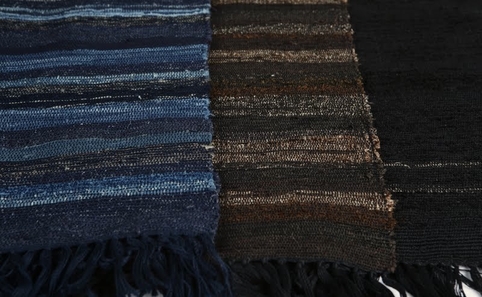The world of sakiori
The ancient Japanese art of recycling used clothing

The lurking cats of Tannakaya
Posted: Mon Jun 20 2011
The backstreets of down-at-heel Kawasaki seem like an odd place to enter the world of sakiori, but it's here that we begin our adventure. A stone's throw from the pachinko lights and high-rise gloom, we're introduced to Kazue Kitabayashi, a sakiori artist and arguably Kanagawa's sprightliest 70-year-old. Sakiori, for which Kazue lives and breathes, might be described as an early form of recycling; it is essentially making new clothes from old rags, stripping used clothing to shreds and working it up into something worth wearing anew.
Kazue has been interested in working with textiles since the age of six, when her uncle, a kimono salesman, would bring around the material he was currently working with to show her mother. Making clothes remained her hobby for many years, but it never went much further than stitching something up for her husband to wear (she claims he hasn't worn anything other than her work for decades). It was only at the age of 60, after coming across a loom at a local craft centre and began to study the art of sakiori (the weaving of old clothes; 'saki' meaning 'to shred', and 'ori' meaning 'weave'), that things moved up a notch. That she managed to build a couple of looms in her own home and then teach herself how to master them to such an advanced level is fairly gobsmacking, though perhaps not so surprising after she casually lets slip that she's also a qualified pilot and is licensed to captain a ship – probably info best left for another story.
She's modest, of course, claiming that the key to her success is the huge collection of used rags that she's been piling up for the best part of three decades, though her daughter-in-law says it's more to do with unrelenting hard work. They've given up trying to get Kazue to go to bed at night, she jokes – when someone enjoys their work so much that they lose all track of time, why stem the passion? We suspect there's more than passion involved here, though; that obsession has fuelled both incessant collecting and the keen desire to improve her art. What else would drive someone to scour moribund farmhouses looking for scraps of used clothing? What else would drive someone to spend uncountable hours cleaning those scraps and stripping them into loom-ready fibres? Her daughter-in-law concurs: once Kazue has an idea in her head, getting her to focus on anything else is virtually impossible.
Whatever the motive, the end product is exquisite. We watch as Kazue feeds the shuttle back and forth through the strings of the loom, lost in her own world, only occasionally lifting a shy eye to the camera to acknowledge our presence. Meanwhile, her niece (there are few members of the Kitabayashi family that aren't involved) brings out some of her completed work. The three-quarter-length overcoats instantly become the most coveted items in the room; large but loose, equally as attractive over a kimono or a shirt and jeans; obviously Japanese in style (Kazue works exclusively in that rich indigo so readily associated with Japanese crafts), though wonderfully adaptable. Elsewhere there are beautifully woven shoulder bags – suspiciously iPad-shaped – and even stuffed toys for children (cats and salmon seem to play a prominent role). We ask her if she takes bespoke orders, but she's quite strict in her response: these are her designs, and beyond the odd minor adjustment (or perhaps an order to fit an unusual size), what you see is what you get. Luckily, what you see is what you never knew you really wanted.
 Kazue proudly points out that she represents the 16th generation of her family to live in Kawasaki, which is why her small company, Tannakaya, remains where it does. It should be noted, however, that her workshop is also her living room, and that – for now – no Tannakaya store exists. You'll soon be able to place your orders via her homepage, however, or let her know you're interested via her Twitter and Facebook accounts (she's probably the only 70-year-old sakiori artist keeping a keen eye on her social media). For now, the best way to get yourself dressed up in an original sakiori overcoat is to swing by the Tannakaya stall at Oedo Antiques Market. Just look for the mass of indigo and the buzzing, bright red beret. Your sakiori adventure starts here.
Kazue proudly points out that she represents the 16th generation of her family to live in Kawasaki, which is why her small company, Tannakaya, remains where it does. It should be noted, however, that her workshop is also her living room, and that – for now – no Tannakaya store exists. You'll soon be able to place your orders via her homepage, however, or let her know you're interested via her Twitter and Facebook accounts (she's probably the only 70-year-old sakiori artist keeping a keen eye on her social media). For now, the best way to get yourself dressed up in an original sakiori overcoat is to swing by the Tannakaya stall at Oedo Antiques Market. Just look for the mass of indigo and the buzzing, bright red beret. Your sakiori adventure starts here.
Kazue's Tannakaya stall will be open at Oedo Antique Market on July 3 and 17. More information can be found at Tannakaya official website

Tweets
- About Us |
- Work for Time Out |
- Send us info |
- Advertising |
- Mobile edition |
- Terms & Conditions |
- Privacy policy |
- Contact Us
Copyright © 2014 Time Out Tokyo














Add your comment